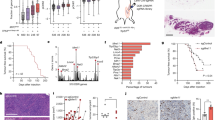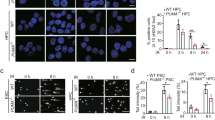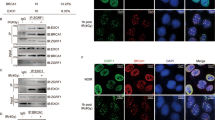Abstract
The p53-inducible gene 3 (PIG3) is originally isolated as a p53 downstream target gene, but its function remains unknown. Here, we report a role of PIG3 in the activation of DNA damage checkpoints, after UV irradiation or radiomimetic drug neocarzinostatin (NCS). We show that depletion of endogenous PIG3 sensitizes cells to DNA damage agents, and impaired DNA repair. PIG3 depletion also allows for UV- and NCS-resistant DNA synthesis and permits cells to progress into mitosis, indicating that PIG3 knockdown can suppress intra-S phase and G2/M checkpoints. PIG3-depleted cells show reduced Chk1 and Chk2 phosphorylation after DNA damage, which may directly contribute to checkpoint bypass. PIG3 exhibited diffuse nuclear staining in the majority of untreated cells and forms discrete nuclear foci in response to DNA damage. PIG3 colocalizes with γ-H2AX and 53BP1 to sites of DNA damage after DNA damage, and binds to a γ-H2AX. Notably, PIG3 depletion decreases the efficient induction and maintenance of H2AX phosphorylation after DNA damage. Moreover, PIG3 contributes to the recruitment of 53BP1, Mre11, Rad50 and Nbs1 to the sites of DNA break lesions in response to DNA damage. Our combined results suggest that PIG3 is a critical component of the DNA damage response pathway and has a direct role in the transmission of the DNA damage signal from damaged DNA to the intra-S and G2/M checkpoint machinery in human cells.
This is a preview of subscription content, access via your institution
Access options
Subscribe to this journal
Receive 50 print issues and online access
$259.00 per year
only $5.18 per issue
Buy this article
- Purchase on Springer Link
- Instant access to full article PDF
Prices may be subject to local taxes which are calculated during checkout












Similar content being viewed by others
Accession codes
Abbreviations
- ATM:
-
ataxia telangiectasia mutated
- ATR:
-
ATM and Rad3 related
- 53BP1:
-
p53-binding protein
- DNA-PK:
-
DNA-dependent protein kinases
- DSBs:
-
double-strand breaks
- NCS:
-
neocarzinostatin
- PIG3:
-
p53-inducible gene 3
- PIKK:
-
phosphatidylinositol 3-kinase-like kinase
References
Abraham RT . (2001). Cell cycle checkpoint signaling through the ATM and ATR kinases. Genes Dev 15: 2177–2196.
Ahn JY, Schwarz JK, Piwnica-Worms H, Canman CE . (2000). Threonine 68 phosphorylation by ataxia telangiectasia mutated is required for efficient activation of Chk2 in response to ionizing radiation. Cancer Res 60: 5934–5936.
Bakkenist CJ, Kastan MB . (2003). DNA damage activates ATM through intermolecular autophosphorylation and dimer dissociation. Nature 421: 499–506.
Bakkenist CJ, Kastan MB . (2004). Initiating cellular stress responses. Cell 118: 9–17.
Bartek J, Falck J, Lukas J . (2001). CHK2 kinase—a busy messenger. Nat Rev Mol Cell Biol 2: 877–886.
Bartek J, Lukas C, Lukas J . (2004). Checking on DNA damage in S phase. Nat Rev Mol Cell Biol 5: 792–804.
Bartek J, Lukas J . (2007). DNA damage checkpoints: from initiation to recovery or adaptation. Curr Opin Cell Biol 19: 238–245.
Bassing CH, Suh H, Ferguson DO, Chua KF, Manis J, Eckersdorff M et al. (2003). Histone H2AX: a dosage-dependent suppressor of oncogenic translocations and tumors. Cell 114: 359–370.
Bulavin DV, Higashimoto Y, Popoff IJ, Gaarde WA, Basrur V, Potapova O et al. (2001). Initiation of a G2/M checkpoint after ultraviolet radiation requires p38 kinase. Nature 411: 102–107.
Burma S, Chen BP, Murphy M, Kurimasa A, Chen DJ . (2001). ATM phosphorylates histone H2AX in response to DNA double-strand breaks. J Biol Chem 276: 42462–42467.
Celeste A, Difilippantonio S, Difilippantonio MJ, Fernandez-Capetillo O, Pilch DR, Sedelnikova OA et al. (2003). H2AX haploinsufficiency modifies genomic stability and tumor susceptibility. Cell 114: 371–383.
Chowdhury D, Keogh MC, Ishii H, Peterson CL, Buratowski S, Lieberman J . (2005). gamma-H2AX dephosphorylation by protein phosphatase 2A facilitates DNA double-strand break repair. Mol Cell 20: 801–809.
Contente A, Dittmer A, Koch MC, Roth J, Dobbelstein M . (2002). A polymorphic microsatellite that mediates induction of PIG3 by p53. Nat Genet 30: 315–320.
Costanzo V, Paull T, Gottesman M, Gautier J . (2004). Mre11 assembles linear DNA fragments into DNA damage signaling complexes. PLoS Biol 2: E110.
DiTullio Jr RA, Mochan TA, Venere M, Bartkova J, Sehested M, Bartek J et al. (2002). 53BP1 functions in an ATM-dependent checkpoint pathway that is constitutively activated in human cancer. Nat Cell Biol 4: 998–1002.
Dupre A, Boyer-Chatenet L, Gautier J . (2006). Two-step activation of ATM by DNA and the Mre11-Rad50-Nbs1 complex. Nat Struct Mol Biol 13: 451–457.
Falck J, Coates J, Jackson SP . (2005). Conserved modes of recruitment of ATM, ATR and DNA-PKcs to sites of DNA damage. Nature 434: 605–611.
Falck J, Mailand N, Syljuasen RG, Bartek J, Lukas J . (2001). The ATM–Chk2–Cdc25A checkpoint pathway guards against radioresistant DNA synthesis. Nature 410: 842–847.
Falck J, Petrini JH, Williams BR, Lukas J, Bartek J . (2002). The DNA damage-dependent intra-S phase checkpoint is regulated by parallel pathways. Nat Genet 30: 290–294.
Flatt PM, Polyak K, Tang LJ, Scatena CD, Westfall MD, Rubinstein LA et al. (2000). p53-dependent expression of PIG3 during proliferation, genotoxic stress, and reversible growth arrest. Cancer Lett 156: 63–72.
Foray N, Marot D, Gabriel A, Randrianarison V, Carr AM, Perricaudet M et al. (2003). A subset of ATM- and ATR-dependent phosphorylation events requires the BRCA1 protein. EMBO J 22: 2860–2871.
Fridman JS, Lowe SW . (2003). Control of apoptosis by p53. Oncogene 22: 9030–9040.
Garg R, Callens S, Lim DS, Canman CE, Kastan MB, Xu B . (2004). Chromatin association of rad17 is required for an ataxia telangiectasia and rad-related kinase-mediated S-phase checkpoint in response to low-dose ultraviolet radiation. Mol Cancer Res 2: 362–369.
Harper JW, Elledge SJ . (2007). The DNA damage response: ten years after. Mol Cell 28: 739–745.
Harris SL, Levine AJ . (2005). The p53 pathway: positive and negative feedback loops. Oncogene 24: 2899–2908.
Horejsi Z, Falck J, Bakkenist CJ, Kastan MB, Lukas J, Bartek J . (2004). Distinct functional domains of Nbs1 modulate the timing and magnitude of ATM activation after low doses of ionizing radiation. Oncogene 23: 3122–3127.
Jazayeri A, Balestrini A, Garner E, Haber JE, Costanzo V . (2008). Mre11–Rad50–Nbs1-dependent processing of DNA breaks generates oligonucleotides that stimulate ATM activity. EMBO J 27: 1953–1962.
Johnson TM, Yu ZX, Ferrans VJ, Lowenstein RA, Finkel T . (1996). Reactive oxygen species are downstream mediators of p53-dependent apoptosis. Proc Natl Acad Sci USA 93: 11848–11852.
Kastan MB, Bartek J . (2004). Cell-cycle checkpoints and cancer. Nature 432: 316–323.
Kirkland RA, Windelborn JA, Kasprzak JM, Franklin JL . (2002). A Bax-induced pro-oxidant state is critical for cytochrome c release during programmed neuronal death. J Neurosci 22: 6480–6490.
Kolas NK, Chapman JR, Nakada S, Ylanko J, Chahwan R, Sweeney FD et al. (2007). Orchestration of the DNA-damage response by the RNF8 ubiquitin ligase. Science 318: 1637–1640.
Lee JH, Paull TT . (2005). ATM activation by DNA double-strand breaks through the Mre11–Rad50–Nbs1 complex. Science 308: 551–554.
Liu Q, Guntuku S, Cui XS, Matsuoka S, Cortez D, Tamai K et al. (2000). Chk1 is an essential kinase that is regulated by Atr and required for the G(2)/M DNA damage checkpoint. Genes Dev 14: 1448–1459.
Macip S, Igarashi M, Berggren P, Yu J, Lee SW, Aaronson SA . (2003). Influence of induced reactive oxygen species in p53-mediated cell fate decisions. Mol Cell Biol 23: 8576–8585.
Mailand N, Podtelejnikov AV, Groth A, Mann M, Bartek J, Lukas J . (2002). Regulation of G(2)/M events by Cdc25A through phosphorylation-dependent modulation of its stability. EMBO J 21: 5911–5920.
Matsuoka S, Huang M, Elledge SJ . (1998). Linkage of ATM to cell cycle regulation by the Chk2 protein kinase. Science 282: 1893–1897.
Matsuoka S, Rotman G, Ogawa A, Shiloh Y, Tamai K, Elledge SJ . (2000). Ataxia telangiectasia-mutated phosphorylates Chk2 in vivo and in vitro. Proc Natl Acad Sci USA 97: 10389–10394.
Melchionna R, Chen XB, Blasina A, McGowan CH . (2000). Threonine 68 is required for radiation-induced phosphorylation and activation of Cds1. Nat Cell Biol 2: 762–765.
Morgan SE, Lovly C, Pandita TK, Shiloh Y, Kastan MB . (1997). Fragments of ATM which have dominant-negative or complementing activity. Mol Cell Biol 17: 2020–2029.
Nicholls CD, Beattie TL . (2008). Multiple factors influence the normal and UV-inducible alternative splicing of PIG3. Biochim Biophys Acta 1779: 838–849.
Nicholls CD, Shields MA, Lee PW, Robbins SM, Beattie TL . (2004). UV-dependent alternative splicing uncouples p53 activity and PIG3 gene function through rapid proteolytic degradation. J Biol Chem 279: 24171–24178.
Nyberg KA, Michelson RJ, Putnam CW, Weinert TA . (2002). Toward maintaining the genome: DNA damage and replication checkpoints. Annu Rev Genet 36: 617–656.
Polyak K, Xia Y, Zweier JL, Kinzler KW, Vogelstein B . (1997). A model for p53-induced apoptosis. Nature 389: 300–305.
Porte S, Valencia E, Yakovtseva EA, Borras E, Shafqat N, Debreczeny JE et al. (2009). Three-dimensional structure and enzymatic function of proapoptotic human p53-inducible quinone oxidoreductase PIG3. J Biol Chem 284: 17194–17205.
Reinhardt HC, Aslanian AS, Lees JA, Yaffe MB . (2007). p53-deficient cells rely on ATM- and ATR-mediated checkpoint signaling through the p38MAPK/MK2 pathway for survival after DNA damage. Cancer Cell 11: 175–189.
Rich T, Allen RL, Wyllie AH . (2000). Defying death after DNA damage. Nature 407: 777–783.
Rogakou EP, Pilch DR, Orr AH, Ivanova VS, Bonner WM . (1998). DNA double-stranded breaks induce histone H2AX phosphorylation on serine 139. J Biol Chem 273: 5858–5868.
Sancar A, Lindsey-Boltz LA, Unsal-Kacmaz K, Linn S . (2004). Molecular mechanisms of mammalian DNA repair and the DNA damage checkpoints. Annu Rev Biochem 73: 39–85.
Shiloh Y . (2001). ATM and ATR: networking cellular responses to DNA damage. Curr Opin Genet Dev 11: 71–77.
Shiloh Y . (2003). ATM and related protein kinases: safeguarding genome integrity. Nat Rev Cancer 3: 155–168.
Stewart GS, Wang B, Bignell CR, Taylor AM, Elledge SJ . (2003). MDC1 is a mediator of the mammalian DNA damage checkpoint. Nature 421: 961–966.
Stucki M, Jackson SP . (2004). MDC1/NFBD1: a key regulator of the DNA damage response in higher eukaryotes. DNA Repair (Amst) 3: 953–957.
Stucki M, Jackson SP . (2006). gammaH2AX and MDC1: anchoring the DNA-damage-response machinery to broken chromosomes. DNA Repair (Amst) 5: 534–543.
Su TT . (2006). Cellular responses to DNA damage: one signal, multiple choices. Annu Rev Genet 40: 187–208.
Tanaka T, Ohkubo S, Tatsuno I, Prives C . (2007). hCAS/CSE1L associates with chromatin and regulates expression of select p53 target genes. Cell 130: 638–650.
Uziel T, Lerenthal Y, Moyal L, Andegeko Y, Mittelman L, Shiloh Y . (2003). Requirement of the MRN complex for ATM activation by DNA damage. EMBO J 22: 5612–5621.
Vogelstein B, Lane D, Levine AJ . (2000). Surfing the p53 network. Nature 408: 307–310.
Vousden KH, Lu X . (2002). Live or let die: the cell's response to p53. Nat Rev Cancer 2: 594–604.
Wang JL, Wang X, Wang H, Iliakis G, Wang Y . (2002). CHK1-regulated S-phase checkpoint response reduces camptothecin cytotoxicity. Cell Cycle 1: 267–272.
Ward IM, Chen J . (2001). Histone H2AX is phosphorylated in an ATR-dependent manner in response to replicational stress. J Biol Chem 276: 47759–47762.
Xiao Z, Chen Z, Gunasekera AH, Sowin TJ, Rosenberg SH, Fesik S et al. (2003). Chk1 mediates S and G2 arrests through Cdc25A degradation in response to DNA-damaging agents. J Biol Chem 278: 21767–21773.
Yang J, Yu Y, Hamrick HE, Duerksen-Hughes PJ . (2003). ATM, ATR and DNA-PK: initiators of the cellular genotoxic stress responses. Carcinogenesis 24: 1571–1580.
Zhou BB, Elledge SJ . (2000). The DNA damage response: putting checkpoints in perspective. Nature 408: 433–439.
Acknowledgements
This research was supported by grants (M 2009-0065519 and M 20706000032) from the Ministry of Education, Science and Technology, the Korean government and from the Chosun University, 2002.
Author information
Authors and Affiliations
Corresponding author
Additional information
Supplementary Information accompanies the paper on the Oncogene website (http://www.nature.com/onc)
Supplementary information
Rights and permissions
About this article
Cite this article
Lee, JH., Kang, Y., Khare, V. et al. The p53-inducible gene 3 (PIG3) contributes to early cellular response to DNA damage. Oncogene 29, 1431–1450 (2010). https://doi.org/10.1038/onc.2009.438
Received:
Revised:
Accepted:
Published:
Issue Date:
DOI: https://doi.org/10.1038/onc.2009.438
Keywords
This article is cited by
-
Downregulation of KRAB zinc finger proteins in 5-fluorouracil resistant colorectal cancer cells
BMC Cancer (2022)
-
Cyanidin-3-glucoside suppresses the progression of lung adenocarcinoma by downregulating TP53I3 and inhibiting PI3K/AKT/mTOR pathway
World Journal of Surgical Oncology (2021)
-
Protein mimetic amyloid inhibitor potently abrogates cancer-associated mutant p53 aggregation and restores tumor suppressor function
Nature Communications (2021)
-
PIG3 promotes NSCLC cell mitotic progression and is associated with poor prognosis of NSCLC patients
Journal of Experimental & Clinical Cancer Research (2017)
-
Methyl methanesulfonate induces necroptosis in human lung adenoma A549 cells through the PIG-3-reactive oxygen species pathway
Tumor Biology (2016)



